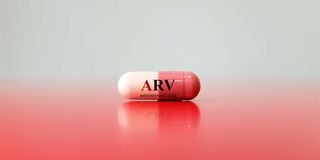Breakthrough HIV drug promises liberation for women

ARV (anti-retroviral drug) -HIV medication. A new long-acting injectable HIV drug administered two times a year, has demonstrated 100 per cent effectiveness, giving fresh hope in the fight and management of the virus.
What you need to know:
- The trial conducted in Uganda and South Africa among more than 5,000 women and girls aged 16 to 25 was actually stopped earlier than planned because of the conclusively positive results.
- The study was published in New England Journal of Medicine on June 24.
Recent reports that the injectable drug Sunlenca (lenacapavir), administered twice a year for protection against HIV, was 100 per cent effective is definitely a breakthrough in the management of this deadly scourge that has terrorised humanity for decades.
The trial conducted in Uganda and South Africa among more than 5,000 women and girls aged 16 to 25 was actually stopped earlier than planned because of the conclusively positive results. The study was published in New England Journal of Medicine on June 24.
A parallel study targeting men, transgender women and gender non-binary people in Argentina, Brazil, Mexico, Peru, South Africa, Thailand and the United States is currently going on. If the study also yields positive results, the world would have made a major stride in annihilating the condition. But even before these results are established, hopefully later this year or in early 2025, this breakthrough has significant gendered implications.
A fact sheet by the UNAIDS Inter-Agency Task Team on Gender and HIV/Aids shows that “young women are disproportionately vulnerable to infection.” It also notes that elderly women and young girls bear the burden of care for infected dependents. Their higher vulnerability means continuous struggle with morbidity and likelihood of death.
The time that they could invest in productive activities is diverted to care work, effectively increasing dependency on other family members. There is also the ever-present danger of transmission to unborn children, notwithstanding the advances in existence to reduce such possibilities. In this context, universal and free access to the drug will transform the landscape for women and girls by reducing their workload and releasing time for other work.
Risk of infection
Considering that half of all new adult infections now occur amongst 15–24-year-olds, majority of them girls, the new drug has potential to drastically save the sexually active ones from the risk of infection. This will significantly reduce the impacts of predatory male sexual behaviour and give women and girls a weapon to apply on their own without male control.
Other advantages are discernible. The drug will eradicate the daily burden of taking pills, hence create convenience and reduce the stigma that comes with having to be discrete. There will also be improved compliance with the treatment regime and reduced cases of defaulting, which are currently high. This will tremendously cut the number of people falling ill and dying. Considering that women are the majority infected, this will certainly have a positive impact on their health and overall welfare, with multiplier effects on society.
Read: HIV breakthrough: New drug trial shows injection twice a year is 100pc effective against infection
A significant group to benefit from this are commercial sex workers, the vast majority of whom are women. By virtue of their work, these women are exposed to multiple partners. One major challenge they face is that of clients who are unwilling to use condoms and are even ready to pay more for unprotected sex, necessitating pre- and post-exposure prophylaxis as well as frequent medical checks, which take time, if not money.
The new drug potentiates to make commercial sex work relatively safe for the women but also for men, and by extension their spouses and other partners. Safer sex means better health, reduced medical expenses and fewer down times.
The injectable drug also implies that women and girls can discreetly seek and get the injection without necessarily seeking the male partners’ approval or control. Given that the drug is administered only twice a year, the frequency of visits to medical service providers is also reduced, and with it the accompanying suspicion.
Best option
The potential of this drug on women’s lives was summarised by Lillian Mworeko, leader of the International Community of Women Living with HIV in Eastern Africa: "For a young woman who can't get to an appointment at a clinic in a town, a young woman who can't keep pills without facing stigma or violence, an injection just twice a year is the option that could keep her free of HIV."
But while the breakthrough is a cause for celebration, what is not is the current prohibitive price. At more than $40,000 for the first year, the medication is obviously beyond the reach of the majority of the people who need it most. This justifies the current calls for large-scale production that will generate economies of scale and make the drug affordable.
It is a moral responsibility of Gilead Sciences Inc., the drug producers, to move with speed towards this goal. As well advocated by Asia Russell, the executive director of Health GAP, “100 per cent effectiveness demands 100 per cent access.”
In addition to affordability, a version of the drug that can be administered once a year, or even after several years, should be the next goal for the scientific community.
The writer is a lecturer in Gender and Development Studies at South Eastern Kenya University ([email protected]).





